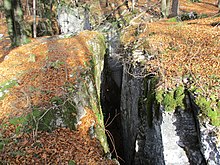Dry gorge
The dry gorges are an area of rugged gorges and boulders in Elsbethen , a southern suburb of the city of Salzburg in Austria . The name of the gorge is due to the fact that no stream flows through the gorge, as is the case with other gorges (for example the Glasenbach Gorge , which is also located in Elsbethen). It is a popular hiking destination for the Elsbethners and the residents of the surrounding area. In 1936 the dry gorges area was declared a natural monument.
The total area of the dry gorges, formerly also called Ulmerberg or Fagerklammen, is around 15,000 m². In this area there are huge boulders and crevices up to 20 m deep , some of which are filled with rotten leaves and from which clouds of fog occasionally rise. The vernacular then speaks of so-called "smoking shafts".
Some of the boulders and crevices are so imposing that they have been named. The best example of this is the French divide , which served the population as a temporary refuge during the harassment by Napoleonic troops . Other examples that are lost or can no longer be located would be the Binderloch , the Jewish Temple and the Hohe Warte .
The dry gorges probably originated by the collapse of a 20 m thick layer of Oberalmer lime on the underlying Lia - marl layer, characterized there was a Felszerreißung. The melting of the Ice Age glaciers , which initially provided support for the boulders, contributed to this process. These tears in the rock also created the Archstein , which is located near the gorge.
literature
- Robert Karl: Elsbethen. A place through the ages. Published by: Elsbethen Municipality, 1994
Individual evidence
Web links
Coordinates: 47 ° 45 ′ 4.8 ″ N , 13 ° 6 ′ 9.9 ″ E

